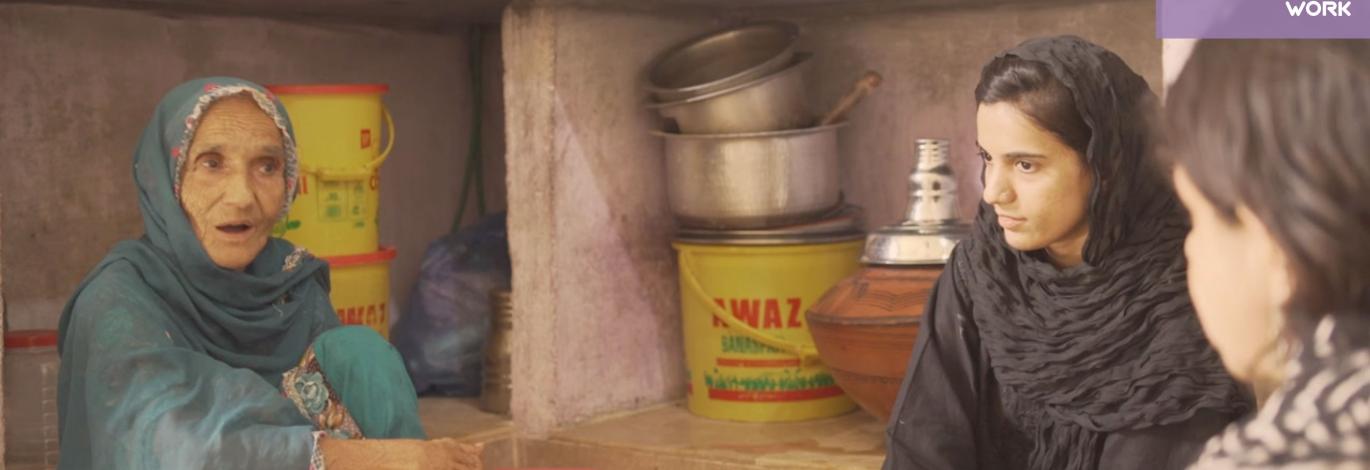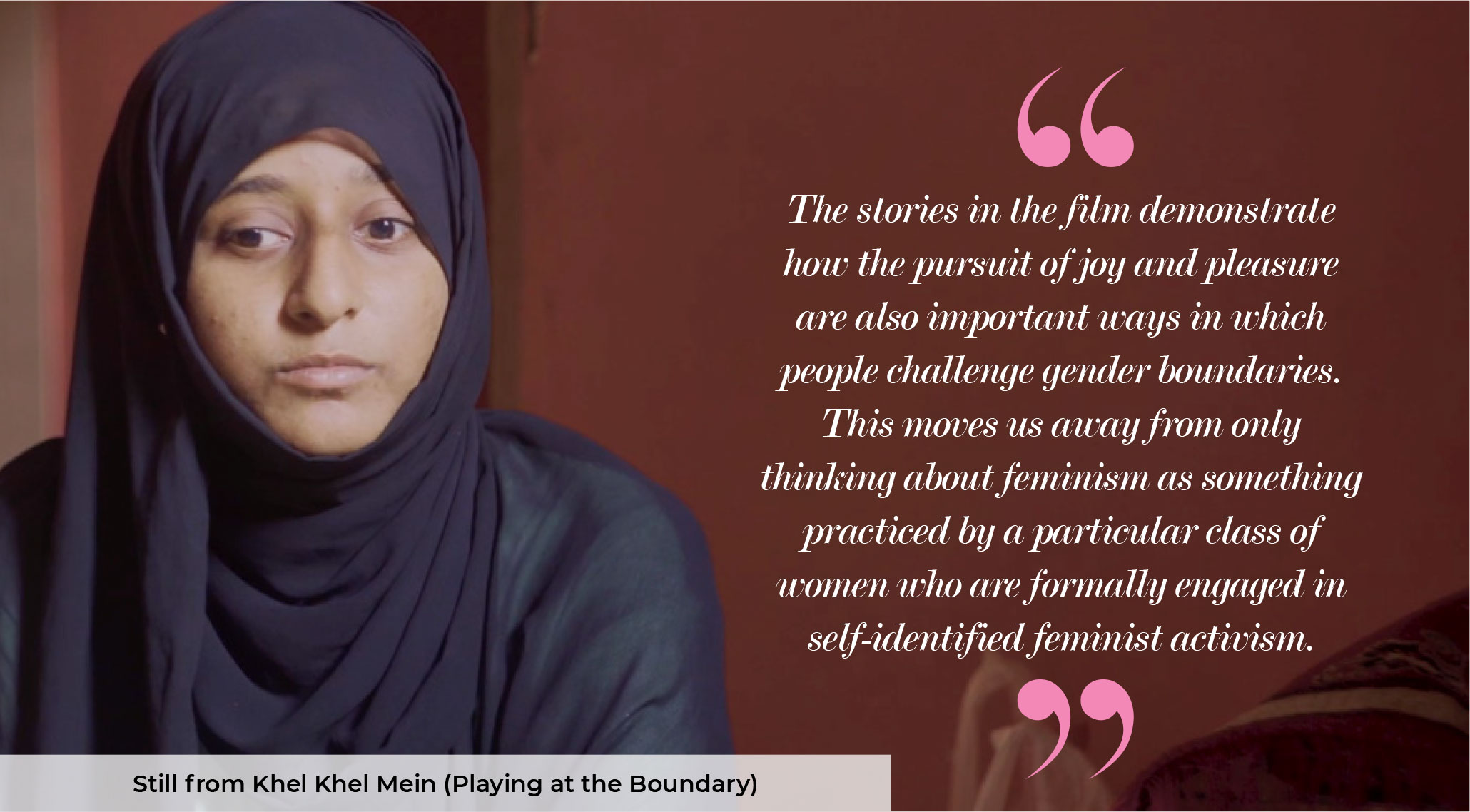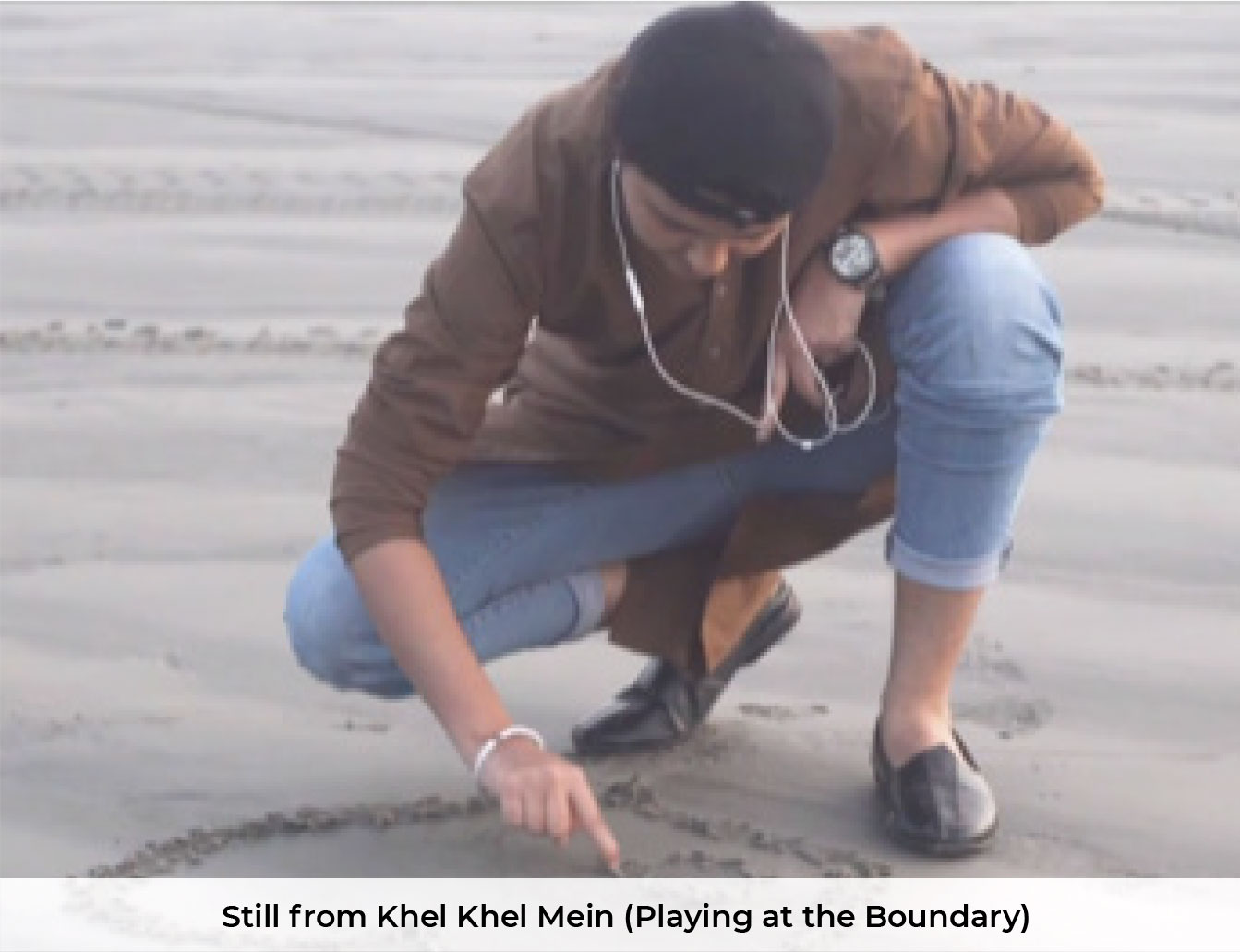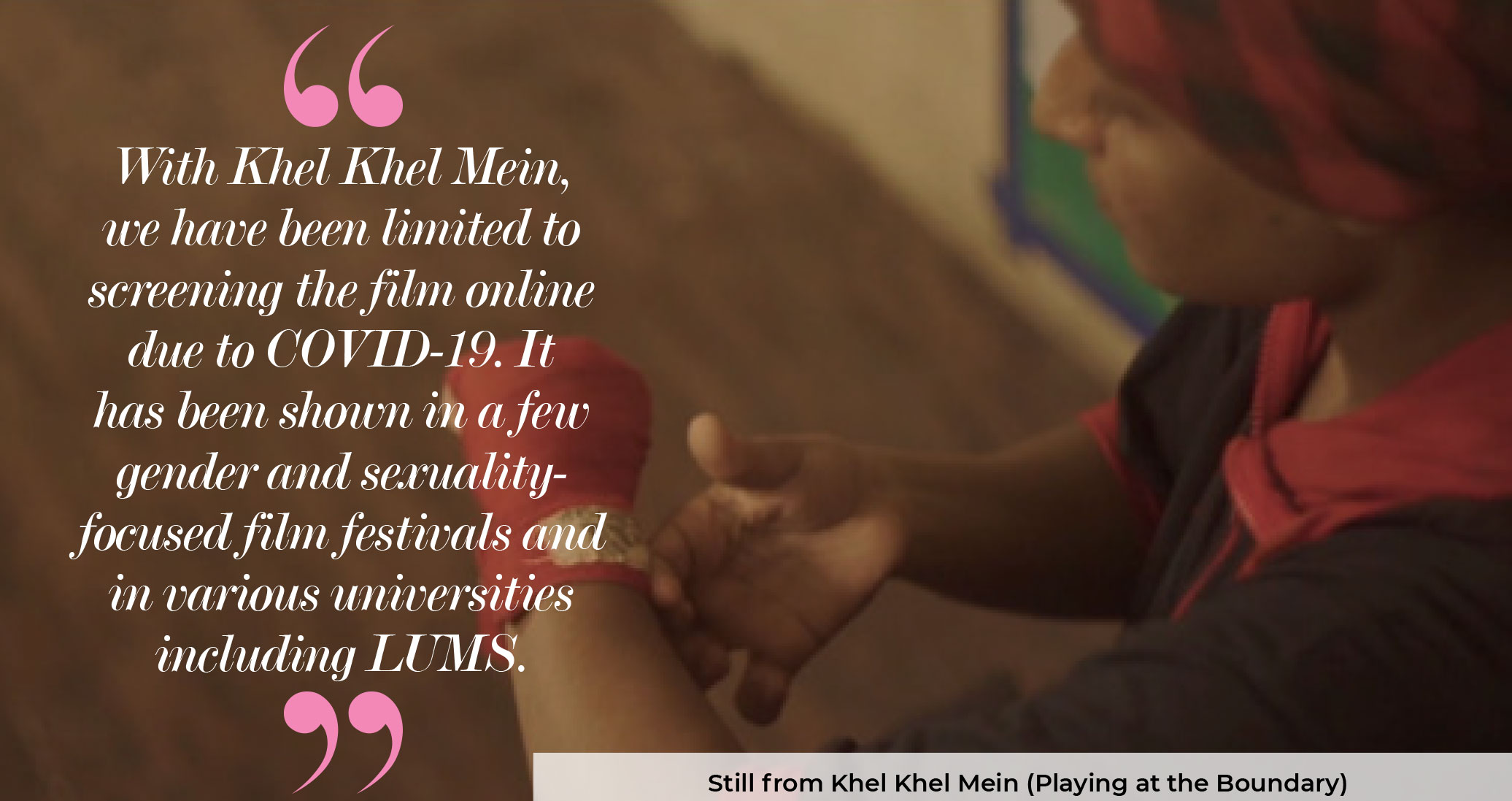
Khel Khel Mein (Playing at the Boundary) is a documentary co-directed by Nida Kirmani and Dostain Baloch, a Karachibased filmmaker who grew up and lives in Lyari, which explores how practices of fun and enjoyment can challenge gender boundaries. The film follows three characters--a boxer, a cycling instructor, and a gender-rights activist--and is based on a paper published by Kirmani last year in South Asia: Journal of South Asian Studies titled ‘Can Fun Be Feminist? Gender, Space and Mobility in Lyari, Karachi.’ Below is a conversation between Kirmani and Kirk, a linguistic anthropologist who has worked extensively on the Punjabi film industry in Pakistan and who teaches in the Comparative Literary and Cultural Studies stream.
GK: The stories presented in the film show very different characters with very different stories and goals, although they all come from the same area and are close in age. Your film links them in several interesting ways, around axes of gender, of freedom, and in its aesthetic treatment. Can you discuss this a little bit--why did you choose these particular stories to highlight, and how do you conceptualize the link between them?
NK: The three individuals featured in the film, Mehreen, Zuleikha, and Sidu, were selected because we felt they embodied different forms of everyday resistance through their pursuit of fun and enjoyment. We wanted to highlight the ethnic diversity of Lyari, so we chose individuals from three communities, which have a large presence in the area. Mehreen is Baloch; Zuleikha is Kutchi, and Sidu is Punjabi, and they are from different neighborhoods as well. This is not an attempt to be representative, but we did want to highlight the diversity of Lyari. We also thought these three characters were dynamic in their own ways. Mehreen is situated within a larger tradition of boxing in the area, although she is part of a newer trend of young women joining the sport. Zuleikha is part of a group that has been making waves locally for the past few years, and their efforts speak to a wider trend of young women claiming public space through activities like cycling. Sidu’s story is a little different in that it is not about sports but about an individual who is challenging gender binaries within and outside Lyari. We wanted to show how Sidu is carrying on with their struggle but how enjoyment and fun are also an important part of their lives. We strived to get away from the oppressed victim narrative that is often present in stories of urban localities in the Global South and in particular about Lyari itself.
GK: In your film, you address that most narratives of Lyari that we see as outsiders revolve around violence and gang warfare, whereas in the film your focus is intentionally different. What do you think these stories offer to perspectives on this area? Also, is there something special that they tell us about this particular place, that might be different from other parts of Pakistan?
NK: That was precisely our intention; we really wanted to move away from only viewing Lyari, and Karachi in general, through the limiting lens of violence. I have been working in Lyari since 2012, and I have repeatedly seen people unfamiliar with the area respond to my frequent visits with shock and awe, as if Lyari were a war zone or just a depressing, poverty-stricken place. I also realised that my own previous work was in many ways feeding into this narrative. For this reason, my co-director Dostain Baloch and I decided we needed to do something different and really highlight the fun aspects of life in this area. We didn’t want to discount the very real experiences of violence and suffering or paint a romantic picture of the place, but at the same time, we really wanted people to see some of the other sides of this vibrant part of Karachi--the parts that make us also love this part of Karachi.
I don’t want to romanticize the place, but I do think that there is an openness in Lyari that is special.
And yes, I would say Lyari is special in that it is one of the oldest parts of Karachi and hence has a really rich history in terms of migration and labour struggles. It is also particularly diverse, with each wave of migration into the area representing another turning point in Subcontinental history. This diversity also means that the people of the area are constantly living in very close proximity to people who are otherwise very different from themselves. For this reason, it seems to be that Lyari is slightly more liberal than other parts of the city. Of course, there is a great deal of conservatism in the area as well, as we saw with the victory of the Tehreek-e-Labbaik Pakistan[1] in the last elections, so again, I don’t want to romanticize the place, but I do think that there’s an openness in Lyari that is special. At the same time, the phenomenon I observe in Lyari, including the ways young people are pushing gender boundaries, are things we would also see in other parts of Karachi and in other places in Pakistan and even beyond. Therefore, like any ethnographic research, my research in Lyari and this documentary have relevance even outside this area.
GK: Much as I appreciate this much-needed intervention around the centering of narratives of violence when it comes to Lyari, I am wondering though whether these stories of enjoyment and fun, of pursuing interests and hobbies, can also be read as a story of resistance or agency in the face of what of course is a very real dangerous security situation (as is briefly mentioned in one or two places in the film) but also in a much larger way, systems of state and patriarchal violence?

 NK: This is what I argued in the paper that inspired the documentary--that fun and enjoyment were important ‘everyday forms of resistance’ to quote James Scott. We wanted to show how resistance does not necessarily have to be in the form of a formal protest or a march and that it did not always have to be serious in nature. The stories in the film demonstrate how the pursuit of joy and pleasure are also important ways in which people challenge gender boundaries. This moves us away from only thinking about feminism as something practiced by a particular class of women who are formally engaged in self-identified feminist activism. We wanted to show how these young people, who may or may not see themselves as part of a wider feminist movement, are also engaged in important forms of feminist politics.
NK: This is what I argued in the paper that inspired the documentary--that fun and enjoyment were important ‘everyday forms of resistance’ to quote James Scott. We wanted to show how resistance does not necessarily have to be in the form of a formal protest or a march and that it did not always have to be serious in nature. The stories in the film demonstrate how the pursuit of joy and pleasure are also important ways in which people challenge gender boundaries. This moves us away from only thinking about feminism as something practiced by a particular class of women who are formally engaged in self-identified feminist activism. We wanted to show how these young people, who may or may not see themselves as part of a wider feminist movement, are also engaged in important forms of feminist politics.
GK: Can you describe the process of making this film, the collaboration that you had? You are an academic and this is your first film; did you find at times that you had to adjust your perspective and approach, coming from a research background and as an outsider to the community (although of course you have been working there for several years)? Did you find certain advantages to the visual medium in terms of telling a particular story about your research site?
NK: Yes, this is my first foray into film direction. I produced a documentary earlier based on another piece of research in Lyari, but this is the first time I was so closely involved in the actual creation of the film, though I should say that Dostain really did take the creative lead as this is his area of expertise more than mine. In terms of the experience, it was really challenging for me as someone who is used to expressing myself through the written word--trying to get across complex ideas without being able to spell them out for the audience and hoping that the message gets across as intended. At the same time, there is an excitement in the medium as the content can only be moulded so much by the director and editor. While we have a huge role in shaping the final product, the characters also have a certain kind of power to tell their own stories in a way that is perhaps not as possible with a journal article. Also, while we are trying to get certain ideas across to the audience, we only have so much control of how they view and interpret the film, which is also quite exciting. This has really come through in some of the conversations we have had with audiences post-screening.

GK: Since the completion of the film, what response has it received, particularly as it travels in different circles? For example, you have shown it in more academic settings, but I am wondering whether it has been shared with audiences in Lyari, or with the people featured in the film, and what reaction has it gotten there?
NK: The film was shared immediately after completion with the folks featured in the film, and thankfully they seemed to really like it, but because of the pandemic, we haven’t really been able to screen the film in the way we might have wanted to during ‘normal’ times. For example, our previous project Don Akhbaar, was screened in various forums within Karachi and in Lyari itself in academic and non-academic spaces. With Khel Khel Mein, we have been limited to screening the film online due to COVID-19. It has been shown in a few gender and sexuality-focused film festivals and in various universities including LUMS, the University of Edinburgh and Queen Mary University in London. However, we would really like to screen it in Lyari itself. Hopefully once we are in a better place in terms of the pandemic, we could organize an outdoor screening there as we know online events might not be as accessible as we would like them to be. In a few months, we will also make the documentary available to the public on YouTube, so hopefully it will be viewed more widely.
Dr. Nida Kirmani is Associate Professor of Sociology at LUMS. Nida has published widely on issues related to gender, Islam, women’s movements, development and urban studies in India and Pakistan. Her book, Questioning ‘the Muslim Woman’: Identity and Insecurity in an Urban Indian Locality, was published in 2013 by Routledge. Her current research focuses on urban violence, gender and insecurity in the area of Lyari in Karachi.
Dr. Gwendolyn Kirk is an Assistant Professor in the Department of Humanities and Social Sciences at LUMS. Her research centers on language ideologies and popular culture in Pakistan, and her current book project addresses questions of language, performance, and aesthetics in Lahore’s Punjabi film industry. In 2020, with film scholar Dr. Zebunnisa Hamid, she cofounded the open-access online journal Reel Pakistan: A Screen Studies Forum. You can also hear her on the podcast Filmi Happy Hour.
